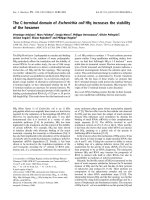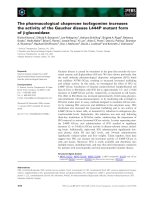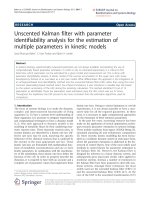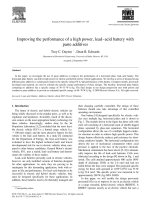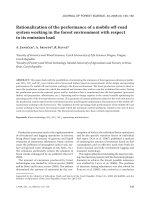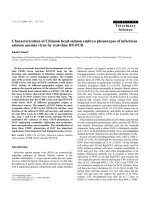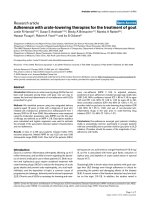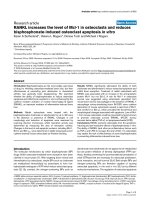Seed priming with nano boron nitride increases the performance of sunflower (Helianthus annuus L.) seedlings
Bạn đang xem bản rút gọn của tài liệu. Xem và tải ngay bản đầy đủ của tài liệu tại đây (407.71 KB, 6 trang )
Int.J.Curr.Microbiol.App.Sci (2018) 7(11): 503-508
International Journal of Current Microbiology and Applied Sciences
ISSN: 2319-7706 Volume 7 Number 11 (2018)
Journal homepage:
Original Research Article
/>
Seed Priming with Nano Boron Nitride Increases the Performance of
Sunflower (Helianthus annuus L.) Seedlings
K.N. Geetha1, Kavita Mahadev Goudar1, N.N. Lingaraju1*,
Ramesh Raddy2 and A.G. Shankar2
1
Department of Agronomy, 2Department of Crop Physiology, UAS, GKVK, Bengaluru,
Karnataka, India
*Corresponding author
ABSTRACT
Keywords
Borax, Nano-boron
nitride, Sunflower,
Seed priming
Article Info
Accepted:
04 October 2018
Available Online:
10 November 2018
A laboratory investigation was initiated to examine the effect of “Seed priming with nano
boron nitride increases the performance of sunflower (Helianthus annuus L.) seedlings” at
Department of Agronomy, University of Agricultural Sciences, GKVK, Bengaluru. The
experiment was arranged in completely randomized design with five replications. Boron
nitride (particle size 70 nm) is used as source of nano boron and Borax [sodium tetraborate
(Na2B4O7·10H2O)] was used as a source of boron. The treatments consist of seed priming
with borax at 0 %, 0.2%, 0.4%, 0.5% and 0.6 % borax and nano boron. Significantly
higher seed germination (88.3%), root length (5.65 cm and 11.4 cm respectively), shoot
length (7.35 cm and 18.14 cm respectively) and vigour index (1286 and 1773,
respectively) at 8 and 15 days after sowing were recorded in seed treatment with nano
boron at 0.2 % seed priming. Significantly lower seed germination (76.7 %), root length
(0.58 cm and 1.28 cm respectively), shoot length (1.03 cm and 5.66 cm respectively) and
vigour index (121 and 532 respectively) at 8 and 15 days after sowing were recorded in
seed priming with 0.6% borax treatment.
Introduction
The cultivated sunflower (Helianthus annuus
L.) is native of southern United States and
Mexico, during later part of 20th century, the
crop was introduced to India. Seed contains
the oil varying from 35-43%.
The unsaturated fatty acids such as oleic and
linoleic comprise about 90% of the total. India
ranks fourth in area coverage of sunflower, but
the production-wise it ranks eighth due to very
low productivity compared to other countries.
Karnataka, Andhra Pradesh and Maharashtra
are the major sunflower growing states
contributing about 91% and 82% of the
countries area and production, respectively
(Rai et al., 2016).
Main reasons for low productivity of
sunflower are poor seed setting and high
percent of chaffy seeds in the centre of
capitulum. The reasons for poor seed setting
are self-incompatibility, absence of pollen
vectors, nutrient imbalance, less irrigation and
low soil fertility. Reddy et al., (2003) reported
503
Int.J.Curr.Microbiol.App.Sci (2018) 7(11): 503-508
that inadequate and imbalanced nutrient
supply is the reason for low productivity of
sunflower. In recent years, micronutrient
deficiencies and their impact on crop yields
are widely reported in various parts. Among
different micronutrient deficiency, boron
deficiency is the second most dominant
problem globally. Boron deficiency has been
reported in 80 countries around the world and
in 132 crops. Sunflower is one of the most
sensitive crops to low boron supply and
required high amount of boron as compared to
other crops and has been used as a good
indicator of boron deficiencies.
Seed priming is the process of regulating
germination by managing the temperature and
seed moisture content in order to maximize
the seed's potential. Several different priming
methods have been reported to be used
commercially, including liquid or osmotic
priming and solid matrix priming. Nano
priming of micronutrients is a new method for
improving germination percentage and
seedling vigour (Dehkourdi and Mosavi, 2013;
Ghafari and Razmjoo, 2013). The amount of
nano boron nitride fertilizer required is very
less in quantity compared to foliar application.
Materials and Methods
A laboratory studies were undertaken at
Department of Agronomy, University of
Agricultural Sciences, GKVK, Bengaluru to
investigate the effect of nano boron seed
priming on seed germination, seedling length
and seedling vigour of sunflower (Helianthus
annuus L.). The experiments were arranged in
completely randomized design with five and
nine treatments replicated five times Viz.,T1Control, T2-0.2 % nano boron seed priming,
T3- 0.4 % nano boron seed priming, T4- 0.5 %
nano boron seed priming, T5- 0.6 % nano
boron seed priming, T6-0.2 % borax seed
priming, T7-0.4 % borax seed priming, T8-0.5
% borax seed priming, T9-0.6 % borax seed
priming.
Boron especially that manufactured via
nanotechnology system has many merits, the
first is the quick and easily uptake by plants.
Such form has lower tendency to leach via soil
and appear its impact for shorter times.
Boron nitride (as a source of nano boron
which is having particle size of 70 nm) and
borax [sodium tetraborate (Na2B4O7·10H2O)]
was used as a source of boron. Since bulk
boron nitride (BN) nano fertilizer will not
dissolve in water and plants cannot absorb it,
the materials were suspended directly in hot
deionised water and dispersed by ultrasonic
vibration (100 W, 40 KHz, 68 amplitude) for
15 minutes. The nano scale suspensions
appear as clear solutions. The pH of all the
prepared suspension was found to be 6.5-7.0.
An absolute control was also maintained. Petri
dishes with filter papers were used for sowing
of seeds.
In general, boron is responsible for enhancing
cell division, pollination and fertilization of
flowers, pollen germination, uptake of water
and various nutrients, the resistance of plants
to various disorders as well as the biosynthesis
and translocation of sugars (Gauch and
Dugger, 1953; Nijjar, 1985). The optimum
quantity range of boron application is rather
narrow, because high concentrations of boron
become toxic to plants (Goldberg and
Glaubig, 1985).
Filter papers were well soaked by adding
distilled water and ten seeds were uniformly
placed per Petri dish (9.5 cm diameter) using a
forceps. All the petri dishes were covered with
lids and kept at room temperature (28 ±2°C).
Germination continued for seven days and
germinated seeds were counted fourth day
after sowing. Parameters such as shoot length,
root length were recorded using a measuring
scale after 8 and 15 days after sowing
respectively.
504
Int.J.Curr.Microbiol.App.Sci (2018) 7(11): 503-508
Results and Discussion
One of the main reasons of low yield of the
sunflower is the deficiency of micronutrients.
The use of essential micronutrients in the right
proportion and optimum quantity is the key to
boost and sustain crop productivity.
Among micronutrient deficiency, boron
deficiency is the second most dominant
problem in the world, which is involved in the
reduction of sunflower production by so many
reasons.
Laboratory studies I
Significantly higher seed germination (94 %)
was recorded in seed treatment with nano
boron @ 0.2 % seed priming over all other
treatments. However, Significantly lower seed
germination was recorded with control (80.9
%) it was on par with seed priming with 0.4 %
nano boron (85.5 %), 0.4 % borax (84.4 %)
and 0.2 % borax (81.8 %).
Different nano boron and borax treatments
significantly influenced the root length at 8
and 15 DAS (Table 1). Significantly higher
root length was recorded with nano boron
0.2% seed priming (6.56, 11.91 cm
respectively) at 8 and 15 DAS.
Lower root length was recorded with control
(3.72 cm) at 8 DAS and 0.2 % borax seed
treatment at 15 DAS (5.93 cm) followed by
control (6.84 cm). The data revealed that there
was a significant difference with respect to
shoot length at 8 DAS and 15 DAS as
influenced by different levels of nano boron
and borax seed priming (Table 1).
Significantly higher shoot length was recorded
with treatment 0.2 % nano boron (7.58 cm and
12.71 cm, respectively) at 8 and 15 DAS.
Lower shoot length was recorded with 0.4 %
borax (2.60 cm) at 8 DAS and 0.2 % borax
(7.87 cm) at 15 DAS. Seed treatment with
nano boron and borax at different levels
showed a significant influence on seedling
vigour index at 8 and 15 DAS (Table 4.2). The
maximum seedling vigour index was recorded
with 0.2 % nano boron (1329 and 2314 plant-1
respectively). Significantly lower seedling
vigour index was recorded with 0.4 % borax
seed priming (555 plant-1) at 8 DAS and 0.2 %
borax (1129 plant-1) at 15 DAS.
Laboratory studies-II
Results showed that higher seed germination
was recorded with 0.2 % nano boron seed
priming (88.33 %) compared to control (75.0
%) (Table 2; Plate 1 and 2). Seed priming with
nano boron @ 0.2 % recorded maximum root
length (5.65 cm and 11.38 cm) and shoot
length (7.35 cm and 18.14 cm) at 8 and 15
DAS respectively. However, the root length
and shoot length were decreased significantly
with the increase in borax concentration. The
lowest root length (0.58 cm and 1.28 cm,
respectively) and shoot length (1.03 cm and
5.66 cm, respectively) were recorded in seed
priming with borax @ 0.6 % which was on par
with 0.5 % borax seed priming.
The decrease in root and shoot length was
mainly due to boron at higher levels which
inhibits root and shoot growth primarily
through limiting cell elongation and cell
division (Brown et al., 2002). Maximum
seedling vigour was recorded with 0.2 % nano
boron seed priming (1145 plant-1 and 2608
plant-1) at 8 and 15 DAS respectively. This
was mainly due to the increased germination
percentage, root length and shoot length of
sunflower seedlings. Significantly lower
seedling vigour index was recorded at seed
treatment with borax @ 0.6 % (121 and 532
plant-1 respectively) at 8 and 15 DAS. The
results are in conformity with the findings of
Habtamu Ashagre et al., (2014) and Prathima
et al., (2016).
505
Int.J.Curr.Microbiol.App.Sci (2018) 7(11): 503-508
Table.1 Germination, root length, shoot length and vigour index of sunflower seedling as influenced by different levels of nano boron
and borax seed treatment (8 and 15 DAS, lab studies DOS: 03.09.2016 - 17.10.2016)
Treatments
Control
0.2 % Nano Boron
0.4 % Nano Boron
0.2 % Borax
0.4 % Borax
S Em±
CD (P= 0.01)
CV (%)
Germination
%
80.9
94.0
85.5
81.8
84.4
1.68
6.98
4.42
8 DAS
Root length
Shoot length
(cm)
(cm)
3.72
6.88
6.56
7.58
4.06
6.80
3.79
4.11
3.98
2.60
0.09
0.12
0.37
0.48
4.52
4.65
Vigour index
858
1329
928
646
555
18.1
74.7
4.68
Root length
(cm)
6.84
11.91
8.16
5.93
8.80
0.16
0.66
4.29
15 DAS
Shoot length
(cm)
9.06
12.71
9.67
7.87
8.85
0.21
0.88
4.92
Vigour index
1286
2314
1524
1129
1489
26.62
109.95
3.86
Table.2 Germination, root length, shoot length and vigour index of sunflower seedling as influenced by different levels of nano boron
and borax seed treatment (8 and 15 DAS, lab studies DOS: 3.01. 2017 - 18.01.2017)
Treatments
Control
0.2 % Nano Boron
0.4 % Nano Boron
0.5 % Nano Boron
0.6 % Nano Boron
0.2 % Borax
0.4 % Borax
0.5 % Borax
0.6 % Borax
S Em±
CD (P= 0.01)
CV (%)
Germination
(%)
75.0
88.3
81.7
78.3
81.7
85.0
86.7
78.3
76.7
2.02
7.98
4.97
8 DAS
Root length
Shoot length
(cm)
(cm)
3.25
6.37
5.65
7.35
4.48
6.52
3.90
6.05
3.01
6.49
2.36
3.56
3.15
4.53
0.48
0.93
0.58
1.03
0.14
0.09
0.57
0.34
9.62
4.084
506
Vigour index
717
1145
901
781
777
503
668
109
121
16.6
65.5
5.21
Root length
(cm)
7.43
11.4
8.24
5.08
4.25
4.89
8.53
1.30
1.28
0.27
1.05
9.11
15 DAS
Shoot length
(cm)
14.30
18.14
15.91
13.53
12.13
14.35
14.48
5.75
5.66
0.26
0.99
4.52
Vigour index
1619
2608
1973
1457
1338
1631
1992
550
532
36.8
146
4.84
Int.J.Curr.Microbiol.App.Sci (2018) 7(11): 503-508
0.2 (%)
0.4 (%)
0.5 (%)
0.6 (%)
Control
Plate 1: Difference in root growth as influenced by different levels of nano boron seed treatment
0.5 % Nano Boron and Borax
0.5 % and 0.6 % Nano Boron
0.5 % Nano Boron and Borax
0.5 % and 0.6 % Nano Boron
Plate 2: Toxic effect of nano boron treated seedling at 22 days after sowing in petriplates
507
Int.J.Curr.Microbiol.App.Sci (2018) 7(11): 503-508
Fariduddin, Q., Hayat, S. and Ahmad, A., 2003,
Salicylic acid influences net photosynthetic
rate, carboxylation efficiency, nitrate
reductase activity and seed yield in
Brassica Juncea. Photosynthetica, 41: 281284.
Gauch, H.G. and Dugger, W. M., 1953, The role
of boron in the translocation of sucrose.
Plant Physiology, 28: 457-766.
Ghafari, H. and Razmjoo, J., 2013, Effect of foliar
application of nano-iron oxidase, iron
chelate and iron sulphate rates on yield and
quality of wheat. International Journal of
Agronomy and Plant Production, 4(11):
2997-3003.
Goldberg, S. and Glaubig, R. A., 1985, Boron
absorption on aluminium and iron oxide
minerals. Soil Sci. Soc. American J., 49:
1374-1379.
Habtamu Ashagre, Ibrahim, A. H., Urgecha Fita
and Ermias Estifanos, 2014, Boron toxicity
on seed germination and seedling growth of
safflower (Carthamus tinctorius L.). Herald
J. Agri. Food Sci. Res., 3(1): 1-6.
Nijjar, G. S., 1985, Nutrition of Fruit, Trees.
Kalyani Publishers, New Delhi, India, p.
100.
Prathima, A. S., Rohini N Met and Shivaramu, H.
S., 2016, Influence of boron seed treatment
on seed germination, seedling length and
seedling vigor in sunflower (Helianthus
annuus L.). Int. J. Sci. Nature, 7(2):273276.
Rai, S. K., Deeksha Charak and Rajeev Bharat,
2016, Scenario of oilseed crops across the
globe. Plant Archives, 16 (1): 125-132.
Reddy, S. S., Yadahalli, Y. H., Kumar, V. K. K.,
Kumara, O. and Naik, A. H. K., 2003,
Effect of fertilizer, gypsum and boron
application on yield and economics of
sunflower hybrids. Crop Res., 23(3): 450453.
Tolerance assay
Root growth inhibition of sunflower seeds by
boron nano particles and borax
In order to develop comprehensive toxicity
profile for nano boron particles, their
phytotoxicity- the ability to cause injury to
plants was also investigated.
Our study examined the effect of five levels of
nanoparticles on seed germination (Table 2) and
seedling growth of sunflower crop and also
observed that higher levels of the nano boron
particles had inhibition on root growth of the
sunflower seedlings (Blackening of the root
tips: Plate 2).
This study confirms the toxicity levels of nano
boron use in sunflower or inhibition of
sunflower seedling growth (root growth) by
boron nano particles.
Seed priming with nano boron 0.2 % showed an
increase in germination percentage, root and
shoot length. Germination per cent, shoot and
root length decreased significantly with further
increase in nano boron concentrations (0.5 %
and 0.6 %).
References
Brown, P. H., Bellaloui, N., Wimmer, M., Bassil,
E. S., Riuz, J., Hu, H., Pfeffer, H., Dannel,
F. and Romheld, V., 2002, Boron in plant
biology. Plant Biol., 4: 205-227.
Dehkourdi, E. and Mosavi, M., 2013, Effect of
anatase nanoparticles (TiO2) on parsley
seed germination (Petroselinum crispum) in
vitro.
Biological
Trace
Element
Research.155: 283-286.
How to cite this article:
Geetha, K.N., Kavita Mahadev Goudar, N.N. Lingaraju, Ramesh Raddy and Shankar, A.G. 2018. Seed
Priming with Nano Boron Nitride Increases the Performance of Sunflower (Helianthus annuus L.)
Seedlings. Int.J.Curr.Microbiol.App.Sci. 7(11): 503-508.
doi: />
508
